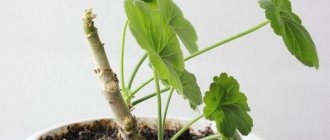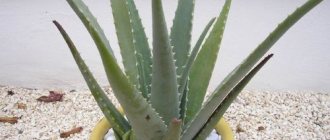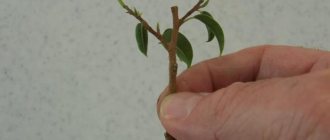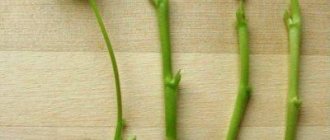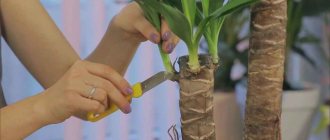Reproduction of geranium in water - features
For a long time, people have been decorating their homes with plants, especially beautiful and long-flowering ones.
Now many gardeners put a lot of effort and imagination into decorating their garden, using perennial and annual plants, ornamental shrubs and herbs for this. Geranium or pelargonium is loved by many flower growers, gardeners and housewives in all corners of the world. This flower is unpretentious, it is easy to care for, the flowering is abundant and long, and most importantly, it is easily propagated by seeds and cuttings. Today we will look at the propagation of geraniums in water . The plant can be grown indoors and in the garden.
I invite you to the group on Subscribe.ru for summer residents and gardeners: “Country hobbies”
geranium propagation in water
Pelargonium propagation
Although it is possible to grow a plant from seeds, this process requires some effort and experience from the grower. And in this case it is not always possible to preserve varietal properties. But propagating geraniums by cuttings in water is much easier, if you take into account the characteristics of the plant and the best time for rooting of cuttings.
Propagation by cuttings
This process is simple and can be done by novice flower growers and housewives. Cuttings not only rejuvenate the mother plant, but also allow you to grow young plants by summer, delighting with abundant flowering and decorating your home or garden with lush caps of bright flowers.
Cuttings completely preserve all the characteristics of the variety, leaf and flower color. This property is valuable when propagating a rare, unique variety.
Optimal cutting time
The result of their rooting depends on the time of cuttings. Experts advise carrying it out from mid-February to March 15-20. During the winter, the geranium stretches out due to lack of lighting, becomes ugly and therefore it is necessary to prune the pelargonium.
Of course, you can take cuttings throughout the year, but you should take into account that in winter the survival rate of cuttings is no more than 50%. Geranium takes root well in September, when the bush begins to grow vigorously, but such a young plant will begin to bloom only next year.
How to cut cuttings?
Remember that they can only be cut from a healthy mother plant.
The sequence of work is as follows:
- to cut cuttings you need to take a sharp knife - a blunt knife can damage the stem tissue, which will reduce rooting and slow down the appearance of roots;
- the knife should be disinfected with an alcohol solution;
- the cuttings must have at least 3-5 leaves, the length of the cuttings is up to 5-7 cm for tall varieties and 2.5-4 cm for short ones, the top of the stem is cut off;
- cut the cuttings at right angles to the main stem;
- the buds or flowers on the stem, as well as the lower leaves, are removed to speed up the appearance of roots;
- The cut must be dried in the shade for about 2-3 hours until a film appears on it.
For reliability and quick rooting, sprinkle the cut with any rooting agent (for example, Kornevin) or keep it for the required time in its solution, prepared according to the instructions on the packaging of the drug.
Propagation of geraniums by cuttings
Through trial and error, I came to the conclusion that the best soil for rooting is a special soilless mixture (peat tablets), which can be purchased at flower shops.
- The mixture is absolutely sterile, there are no additives in it, so the cuttings take root in it perfectly.
- There are no bacteria in the soilless mixture, which means that the cuttings will not rot, which happens quite often when using garden soil.
For containers, I choose ordinary disposable cups of different colors: transparent, white or dark. I root pink, white or red geraniums in them, respectively, so that when planted in pots I get uniform compositions. If you need to root geraniums of the same color, it is more convenient to use transparent cups - the roots are clearly visible in them. First, I make drainage holes in the cups with a knife.
Photo: containers for geranium cuttings
- A week before cuttings, I water the geranium with any fertilizer for indoor flowers to enhance the growing season.
- I use a dose 2 times less than indicated in the instructions.
- Before watering with this fertilizer, I water the soil with a small amount of water so as not to burn the roots.
Pruning geranium cuttings
- I arm myself with sharp scissors and cut off the tops of the shoots with the first two internodes. Such cuttings are usually 15 - 20 cm long.
- Side shoots of the same length are also suitable for cutting.
- If, after cutting the top of the stem, there are shoot buds in the internodes, then I also take this part of the stem to the cutting.
Photo: geranium cuttings from the top of the stem In the case when new shoots between the stem and the leaf are not visible on the remaining stems, I do not use them to obtain cuttings, I leave them in this form.
Such geraniums with tall, almost bare stems look very unsightly, but literally after 2 weeks shoots will appear from the internodes, and the remaining stems can be cut into cuttings again.
Photo: geranium cuttings from the top and middle of the stem Even if so many cuttings are not needed, I am in no hurry to shorten the remaining stems after the first cutting. I finally cut the stems at a level of 10 cm above the soil only when the first batch of cuttings have taken root, so that in case of unsuccessful cuttings there is spare material. After the second cutting of the cuttings, the queen cells produce new shoots and bloom luxuriantly by mid-May. In May, I replant the plants, replace the soil with well-rotted compost, after which flowering continues until the end of autumn. I save the queen cells for 3 - 5 years, after which I replace them.
How to prune geraniums
- From cut cuttings, I remove all leaves except one top or side one.
- If the leaf blade is large, I cut half of it.
- The remaining leaf should be short and smaller in size compared to the rest.
- If a new leaf is just starting to open from the top of the shoot, I leave that one and cut off the rest.
- All buds and flowers must also be cut off.
- There is no need to leave more than one leaf, otherwise the geranium cuttings will not have enough strength to feed it and form roots at the same time.
- Using a sharp knife, I cut the bottom of the cutting diagonally and leave the cuttings for a couple of hours so that the cuts dry.
Rooting cuttings
It can be carried out in two ways: in water or soil mixture.
propagation of geraniums by cuttings in water
Propagation of geraniums by cuttings in water
This method is quite simple and allows you to get good roots if done correctly.
- The water is pre-settled and poured into opaque glasses (or plastic ones).
- Activated carbon tablet powder is added to the water to prevent stem rotting and the appearance of pathogenic microorganisms.
- Only half of the cutting is placed in water, which is changed periodically, preventing it from blooming and evaporating.
- It is better to place the glass in a bright place and shade it.
- When the roots grow to 2.5-3 cm, the plant can be planted in a pot with soil.
Planting in soil mixture
Cuttings with a dried cut can be immediately planted in a separate or common container in the following sequence:
- use a container with a volume of more than 200 ml as a container (a plastic glass will do);
- make a drainage hole in the glass;
- buy special soil or prepare a mixture of peat, perlite and sand in equal proportions;
- any mixture must be poured with a hot pink solution of potassium permanganate;
- first, make a drainage layer of expanded clay or pieces of polystyrene in a glass, then fill the soil mixture to the top and place the cuttings, deepening them by about 4 cm and placing them in the shade for 3-4 days, after which they are placed in a bright place, but without direct sunlight;
Water the plant as the soil dries, but it is better to pour water into the pan.
If the leaf begins to sag or turn yellow, then the seedlings should be placed under a film or jar to create a microclimate.
Caring for young plants
The appearance of new leaves signals the rooting of the young plant. Therefore, now geraniums can be transplanted into another container that is not much larger than the previous one, since geraniums do not require a lot of land. It has been noticed that in a spacious container the plant begins to bloom much later as it first grows a root system to fill the pot. You can plant several plants in a large container.
What is a cutting, how to choose and prepare it correctly?
A shoot, or cutting, is a cut part of a plant with one or more nodes.
This cut off part is precisely used for vegetative propagation (by cuttings). In order to get a new geranium, completely identical to the previous one, you first need to select this cutting. When should you take a cutting from the mother flower in order to plant and grow a young plant? The mother plant should be well developed and absolutely healthy, ideally it should be 2 - 3 years old. You need to select the apical cuttings of the mother geranium. This process should be 7–8 cm in length, have one or more nodes (buds, growth points) and 3–5 leaves. If there are leaves left at the base of the cutting, they must be carefully removed.
If the branches of the shoot are the same length as the shoot itself, then you definitely need to cut them off, and then you can use them as independent cuttings. And the finished shoots are left in the air so that the cut areas dry out. If after a few hours they are covered with a thin film, it means that everything went well and the cuttings are ready for the next stage.
Wrong cutting selected
Geranium may not take root in water due to the fact that the cuttings were chosen incorrectly. To prepare viable shoots, follow these recommendations:
- For planting, select cuttings from the apical part of a young flower, from the side shoots.
- Do not water the mother plant before cutting.
- Use a sanitized knife.
- Cut a 5-8 cm piece of stem as close to the bud as possible.
- Remove the lower leaves, peduncles and buds from the shoot.
Pelargonium cuttings
How to cut and prepare a geranium shoot
When is the best time to cut a cutting for rooting?
Since the plant is indoors almost the entire year, you can cut a cutting from it at any time. However, due to the lack of natural light in autumn and winter, such a shoot can not only take root for a very long time, but can also stretch out considerably during autumn and winter.
Sometimes the rooting process can be delayed due to the fact that the mother bush has fallen into a dormant state. Therefore, it is most convenient to start propagating the plant by shoots at the end of winter. The best time to obtain and root a shoot is mid-spring - early summer. Sometimes this can be done in August, when the plant finishes its flowering period.
How to prepare a cutting
If the mother plant has managed to form buds, then the flower stalks must be removed before taking cuttings. To cut the cuttings you will need a sharp, clean knife. Its blade must be treated with an alcohol-containing liquid.
Cut off a part of the shoot up to 7-8 cm long. Most often, the apical part is suitable for cutting. The cut is made just below the internode. Important! The cut section should have at least 3-4 internodes or full leaves. Do not rush and immediately place the cuttings for rooting in water or dig them into the ground.
He needs to be given time to just lie in the open air. Any place out of direct sunlight is suitable for this. After the cut part of the plant has been left for three to four hours, you need to sprinkle the cuts with any root-forming agent or charcoal crushed into dust. After this, you can begin rooting geraniums.
Errors during the rooting process
Soaking in water is not used for all varieties of pelargonium. Royal and fragrant must be planted in the ground immediately, otherwise their cuttings will rot. Ivy geranium can be nourished by internal juices for a long time, so roots do not appear. If after 3 weeks the sprout begins to sprout new shoots, rooting will be successful.
Water soaking of shoots is best for geranium zonalis. Leave the liquid for this purpose for 3 days, then add 1 tablet of activated carbon and 1 tbsp. l. Kornevina per 200 ml of water.
Rooted geranium cuttings
To eliminate errors, consider the following nuances:
- Use small containers, such as 200 ml plastic cups. Each should have no more than 1 shoot.
- Pour water to half the volume of the glass, because... The plant needs oxygen to form roots. The liquid should cover only one third of the process.
- Use dark glass containers. Place them in a bright place, but protect them from direct sunlight.
- Do not completely change the water in the cups, but add it as it evaporates, approximately once every 2-3 days.
- Transplant the shoot into a pot after 2-3 weeks, when the roots grow to 3 cm.
How to carry out the procedure?
The cut shoots do not yet have roots, which are necessary for the development of full-fledged geraniums, so after their preparation it is necessary to root the cuttings. This can be done in water or directly in the prepared substrate.
Rooting cuttings in water
How to propagate a plant by placing cuttings in water? The main advantage of this method is the ability to observe the process from beginning to end and not miss the moment when the shoot has roots and can already be planted in the substrate.
Rooting in water also has its significant disadvantage: sometimes the cutting can rot before it even takes root, and in order to prevent this, gardeners strongly recommend adding crushed activated carbon to it for disinfection every time you change the water.
Using this method, you can get beautiful and healthy geraniums.
Rooting in the ground
Is it possible to plant a cutting without roots directly into the ground? Thanks to rooting in the ground, you don’t have to worry about the shoots rotting, since this happens extremely rarely, but you won’t be able to see when the roots will appear, which is why the planting material sometimes gets spoiled by being replanted ahead of time. How to plant correctly can be read in the instructions:
Tips for gardeners on how to root geraniums easily and without problems
Geranium has beautiful flowering and can decorate any windowsill or garden. Of course, you can buy an already mature flowering one for home, but sometimes it’s more interesting to grow a flower yourself. Therefore, many are interested in propagating this plant at home.
To do this, cuttings are most often carried out, because When propagating from seeds, geraniums have to wait a much longer time for flowering.
How does rooting occur?
Geraniums are propagated in different ways, but often by cuttings, when existing plants are used.
The plant can be rooted in water and soil. Experienced gardeners believe that the process of formation of the geranium root system occurs faster in the soil, but a more viable root is formed in water.
If cuttings are rooted in the ground, you must take into account the requirements:
to cuttings;- to the ground.
How to take cuttings correctly:
- Use only strong and healthy cut shoots.
- The lower leaves are removed.
- Cut cuttings 7-10 cm long.
- Cuttings are made between two leaves.
- At the bottom, the cut should be made below the bud, without leaving the stem, which can rot in water.
- At the top, the cut is made above the bud, without leaving a stem above it, so that the new shoot does not grow to the side and not up.
- The sections must be dried for two hours to form a protective film.
Preparing geranium cuttings for planting
Geraniums can be grown from seeds, root division and stem cuttings. To plant geraniums without roots, you need to correctly perform the pruning procedure. Tip cuttings are ideal for plant propagation. They should be cut under the bud so that the length is 7-8 cm and there are 3-5 leaves left on each of them. The cut should be oblique. The lower leaves are removed.
If after pruning the plant has long branches left, they can also be cut into cuttings of the same length with two to three pairs of leaves and used for rooting.
Finished cuttings should be left to air dry. After a couple of hours, the cut and places where the leaves are broken will be covered with a thin film. The cuttings are ready, it’s time to choose a rooting method.
When is the best time to do this?
You can experiment at any time of the year. But experienced gardeners believe that geranium takes root faster in the spring.
Summer heat has a negative effect on seedlings , and with high humidity there is a possibility of developing “black leg”.
It is almost impossible to save the affected plant from the “black leg”. The disease develops quickly, the trunk rots from the very root and pruning does not help. When watering, it is better to pour water into the pan to avoid waterlogging of the soil.
If you propagate geranium in the fall, it will have to create greenhouse conditions:
place seedlings under lamps for at least 17 hours a day;- the air should be heated to 23 degrees Celsius;
- In autumn, rooting takes longer, amounting to 35-40 days.
So, for geranium cuttings to take root well, the best period is considered to be from the end of February to May, but your own experience may refute this statement. Rooting is influenced by many factors and each gardener has his own conditions. And yet, in the spring, geranium is always accepted.
When can a flower be propagated in this way?
Geraniums can be propagated by cuttings all year round, but flower growers are of the opinion that during the dormant period (mid-autumn - end of winter) it is better not to touch the plant, because at this time it is very vulnerable, and therefore the mother geranium may die. Therefore, the most optimal period is spring, when geraniums begin their growing season and are still full of previously accumulated strength.
Propagation of a plant such as geranium is a fairly simple process that anyone who takes it upon can do it. And proper and timely care for a rooted plant will help it delight the eye with its attractive and aesthetic appearance.
If you find an error, please select a piece of text and press Ctrl+Enter.
Source
How to make pelargonium take root in water?
One way to root geranium is to place the cuttings in water and keep them in a warm room for 2-3 weeks.
Instructions:
- place the prepared cuttings in an opaque (since the roots need darkness) container with water;
- use regular water in a 5 cm layer and with the addition of crushed activated carbon;
- The water should be changed every two to three days;
- place the container in a place where there is diffused sunlight, and not direct rays;
- When the shoots take root, they must be transplanted into the ground.
You can find out more about how to grow geranium from seeds at home and care for it after that.
Convenience of rooting pelargonium cuttings in water
Recently, we have completely switched to rooting cuttings in water, as my mother and grandmother did. For us, this method of propagating pelargoniums saves a lot of time and space. And the result is no worse than when rooting cuttings in the substrate.
Please note: when rooting pelargonium cuttings in water, you should not let their roots grow too long! Otherwise, the plant will experience stress when planted in the ground. It is enough to wait for the pelargonium cuttings to have roots that are only 2-3 mm long - and plant the cuttings in a pot!
Possible problems and solutions
Sometimes cuttings can remain in water for a long time without forming roots.
Why geranium does not take root in water:
- air temperature above 25 degrees , and this has a bad effect on the development of roots;
- ivy geranium , and this species can be nourished by internal juices for a long time and not take root.
What to do to make roots appear:
- remove the cutting from the water;
- update slice;
- dry overnight;
- In the morning, plant in slightly moist soil.
Way to solve the problem
Geranium cuttings from pruning to planting
If all the recommendations are followed, but the geranium does not root in water on time, the problem can be solved. To do this, follow the instructions:
- Remove the cutting from the water.
- Update the slice.
- Dry the shoot overnight.
- In the morning, plant the plant in slightly moistened soil.
How to carry out the whole process quickly and without losses?
Sometimes a positive result may not be achieved by following seemingly all the rules. The reason is that the rooting process has its own secrets and subtleties :
In the soil, not only its composition is important, but also its acidity, because... geranium does not like elevated temperatures. Peat is characterized by oxidation, and store-bought soil contains 80% peat.- If during the rooting process all the leaves of the pelargonium have fallen off, there is a possibility that there will be no use anymore, but if only a part has turned yellow and withered, it is possible that it will take root.
- Pots with cuttings can be placed in a greenhouse, for example, under tomatoes - and the light will be diffused and the greenhouse will be ventilated; the lower leaves sometimes turn yellow, but the top will be green and strong.
- Feeding is avoided until the roots grow.
- If the cutting has a flower, it must be removed so that rooting does not slow down.
- Once warmer weather sets in, geraniums should be placed on a balcony or loggia, because... insufficient lighting will lead to loss of decorativeness.
Harvesting cuttings
The younger the mother plant, the greater the chance of rooting its cuttings. Plants older than 7 years may not produce viable shoots at all.
You can harvest cuttings at any time of the year. The greatest likelihood of rooting is for shoots planted in the spring, when daylight hours increase. During this period, plants wake up from winter dormancy, they are ready to grow, and active sap flow begins in the tissues. Cuttings cut in winter or late autumn will take longer to take root and are less likely to succeed.
The cuttings are cut with a sharp, disinfected knife at a right angle to the trunk, 1 cm below the node. The shoot should be 5–7 cm long, with 2–3 leaves. If the branch you like already has flowers or buds, they need to be cut off, otherwise the plant will spend energy on flowering rather than on forming roots.
Before planting, the resulting shoot is dried for several hours at room temperature in the shade; the cut should be covered with a film. If you immediately plant it in the ground or put it in water, an infection can get on its unprotected surface and there is a risk of rotting. Leaves that are too close to the cut are removed.
How to cut a cutting
Pelargonium can be grown at home for up to 10 years, but most often its trunk is bare, leaves grow only on the tops of the branches. This is why gardeners prefer to rejuvenate plants after a few years. With shoots and cuttings you can grow from 5 to 10 new plants from one mother plant, knowing how to cut and root them.
Is it possible to do this all year round? Yes, but the percentage of rooted cuttings is much higher in spring and summer. If the mother plant is at rest, then rooting will occur very slowly, and the geranium shoot may rot. The process occurs much faster at the beginning of the growing season, that is, the best time is from March to May and from July to early September, when geraniums no longer bloom.
The apical shoot can most easily produce roots. You need to cut off a branch with 4-5 leaves using a sharp, disinfected tool. Each cutting 5–7 cm long must have several leaves or internodes. Before planting, the lower leaves must be removed, as well as the resulting buds.
How to plant?
What is required for planting:
- prepare the soil (avoid stagnation of water, add rotted compost and peat);
- make planting holes (deep - designed for a branched root system, with drainage at the bottom);
- plant seedlings , compacting the soil around the plant;
- water abundantly (such watering is allowed only during planting);
- mulch the soil from drying out (spread organic mulch: bark, wood chips, dry peat, compost).
- What do geranium seeds look like in the photo and how to collect them at home?
- Peculiarities of propagation of geranium leaves.
Aftercare
Once geranium is planted in the ground, it, being an unpretentious plant, requires minimal care.
- in watering (when planting you need plenty, and then moderate when the soil is already dry);
- in fertilizing (applying compost and peat during planting is usually sufficient);
- and pruning (for decorative purposes and for preventive purposes, to protect healthy parts of plants from rot).
Experience will help you root geraniums without losing planting material. There is no need to despair if the first result is not what you would like. After all, it depends on the type of geranium, and on the soil, and on the time of planting, and on other conditions. Only experiments will provide the necessary experience.
How to carry out the procedure?
The cut shoots do not yet have roots, which are necessary for the development of full-fledged geraniums, so after their preparation it is necessary to root the cuttings. This can be done in water or directly in the prepared substrate.
Rooting cuttings in water
How to propagate a plant by placing cuttings in water? The main advantage of this method is the ability to observe the process from beginning to end and not miss the moment when the shoot has roots and can already be planted in the substrate.
Rooting in water also has its significant disadvantage: sometimes the cutting can rot before it even takes root, and in order to prevent this, gardeners strongly recommend adding crushed activated carbon to it for disinfection every time you change the water.
Using this method, you can get beautiful and healthy geraniums.
Rooting in the ground
Is it possible to plant a cutting without roots directly into the ground? Thanks to rooting in the ground, you don’t have to worry about the shoots rotting, since this happens extremely rarely, but you won’t be able to see when the roots will appear, which is why the planting material sometimes gets spoiled by being replanted ahead of time. How to plant correctly can be read in the instructions:



